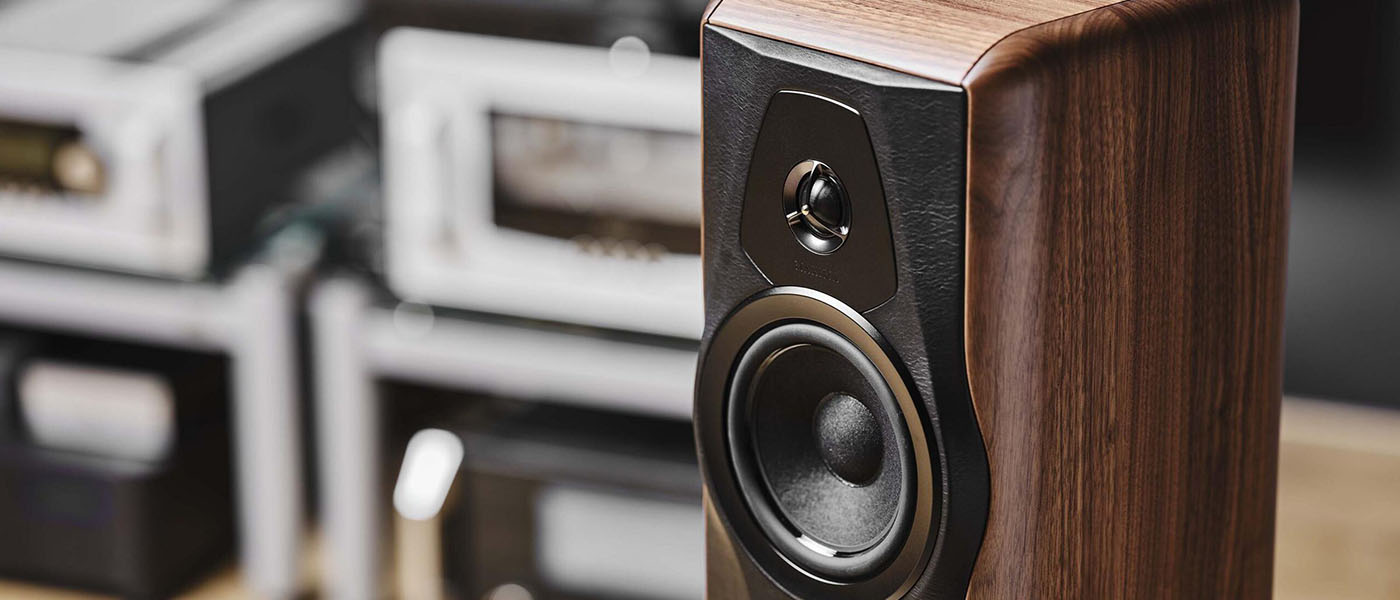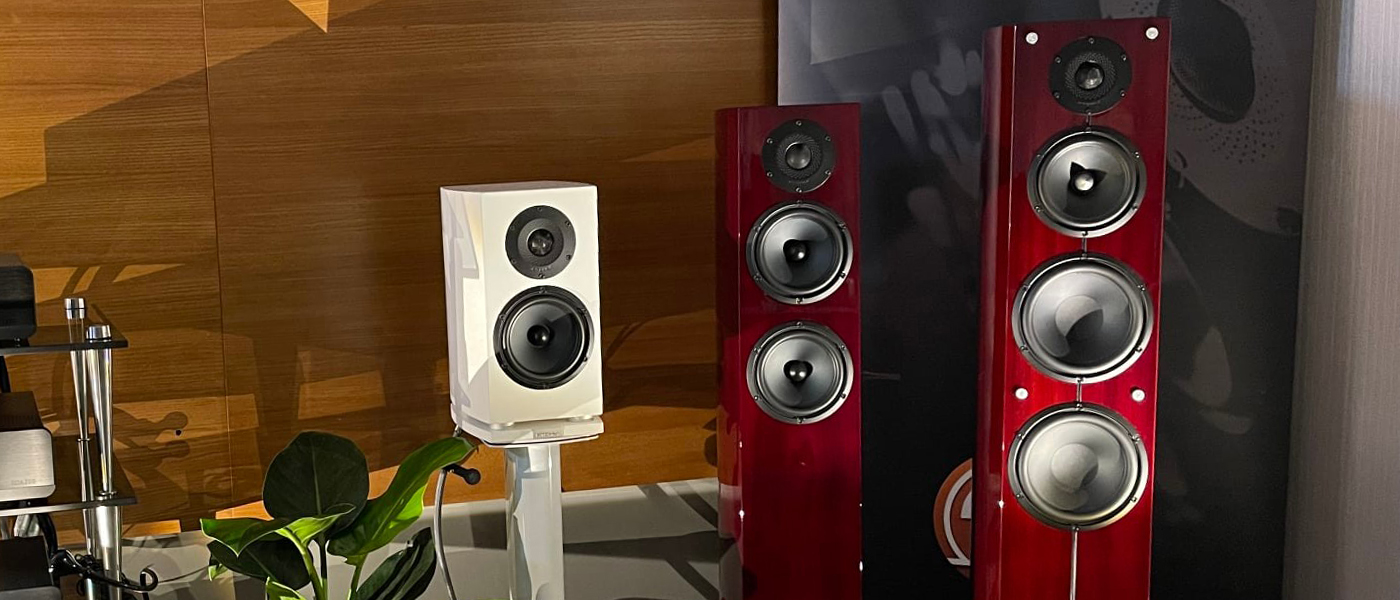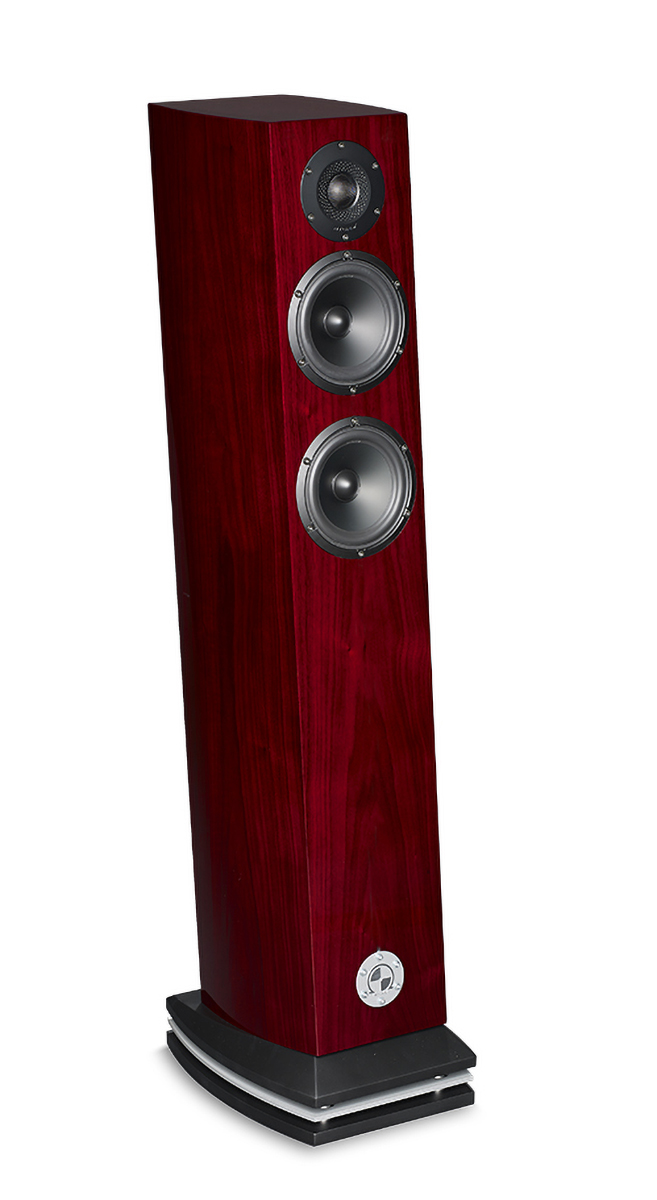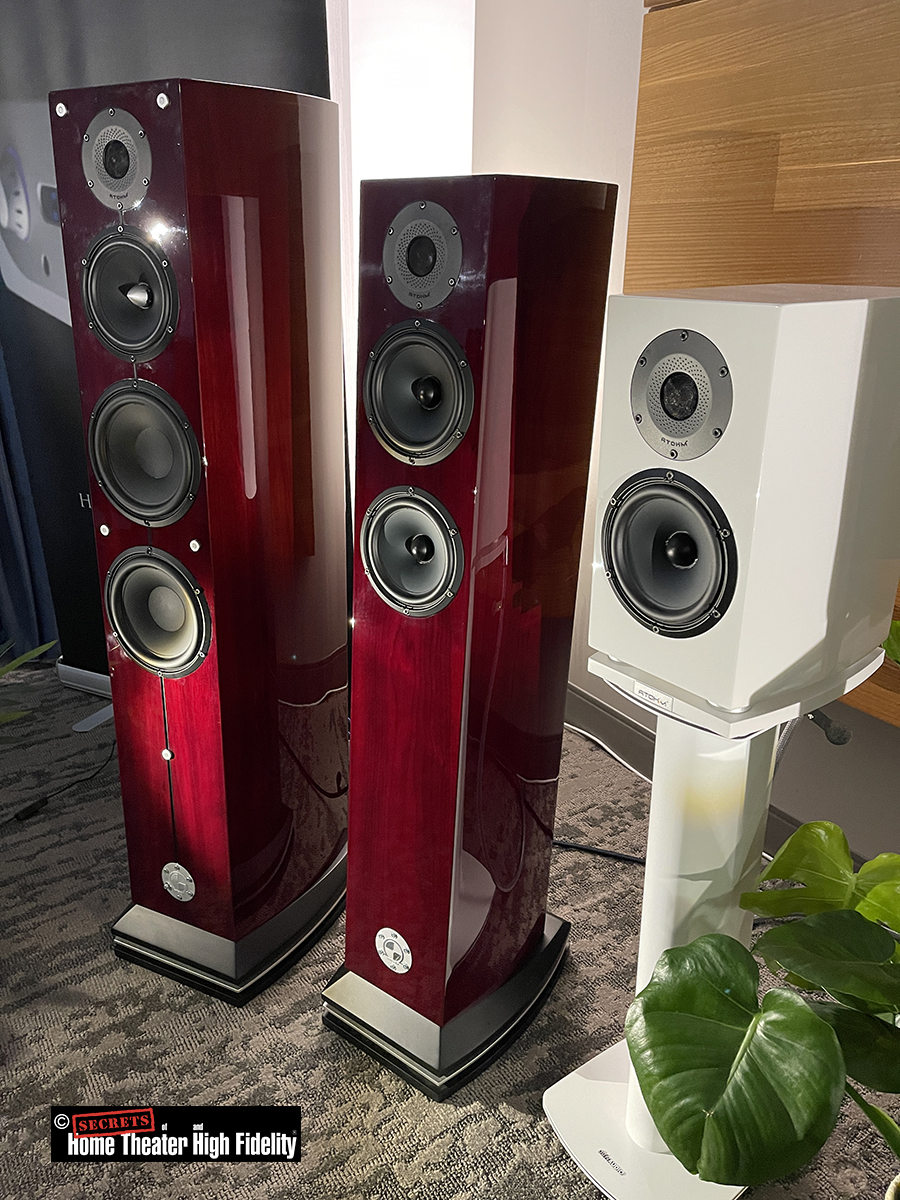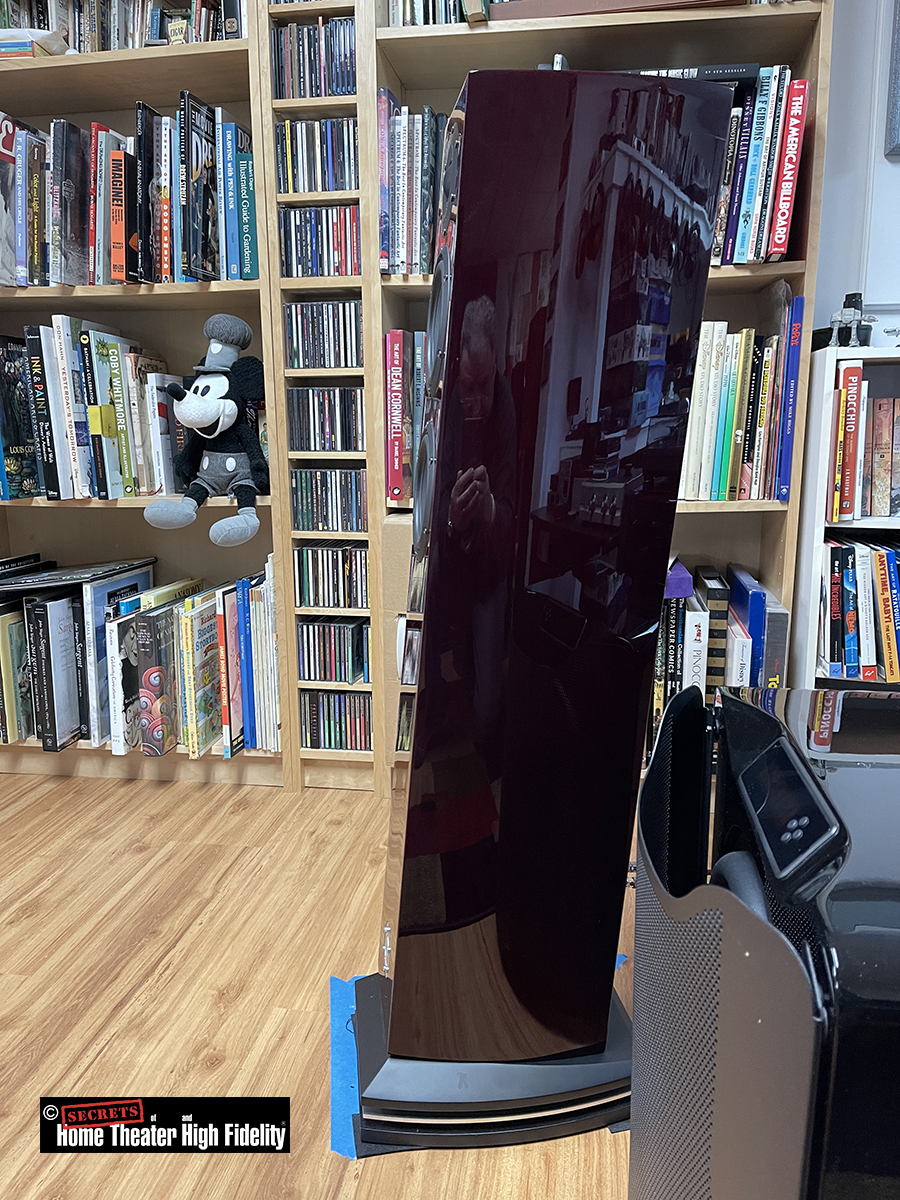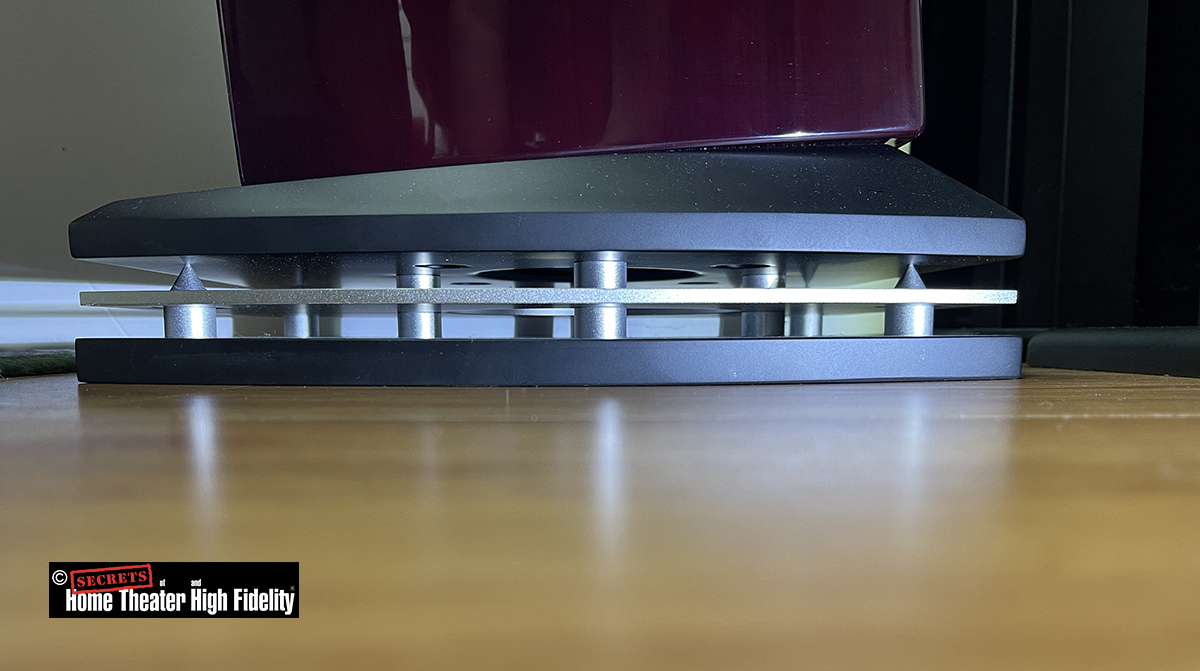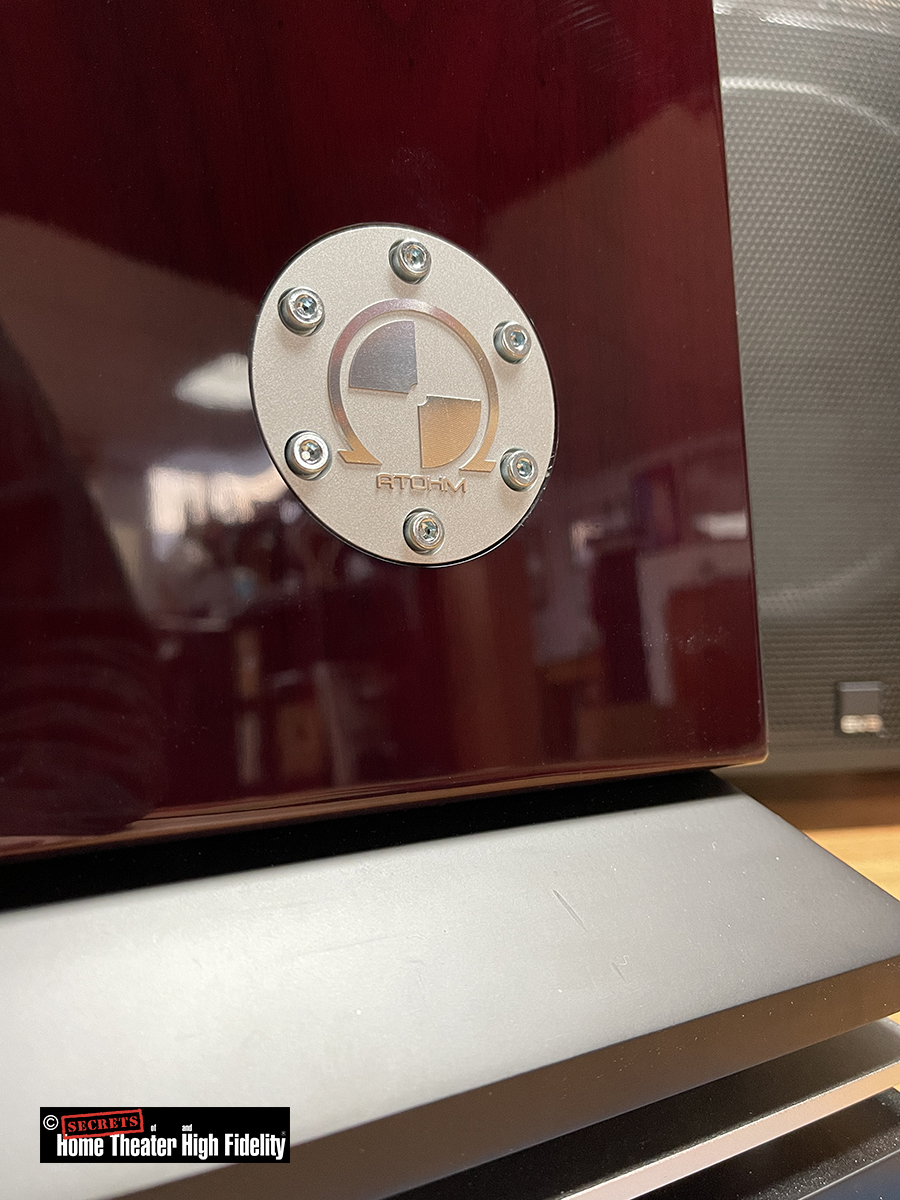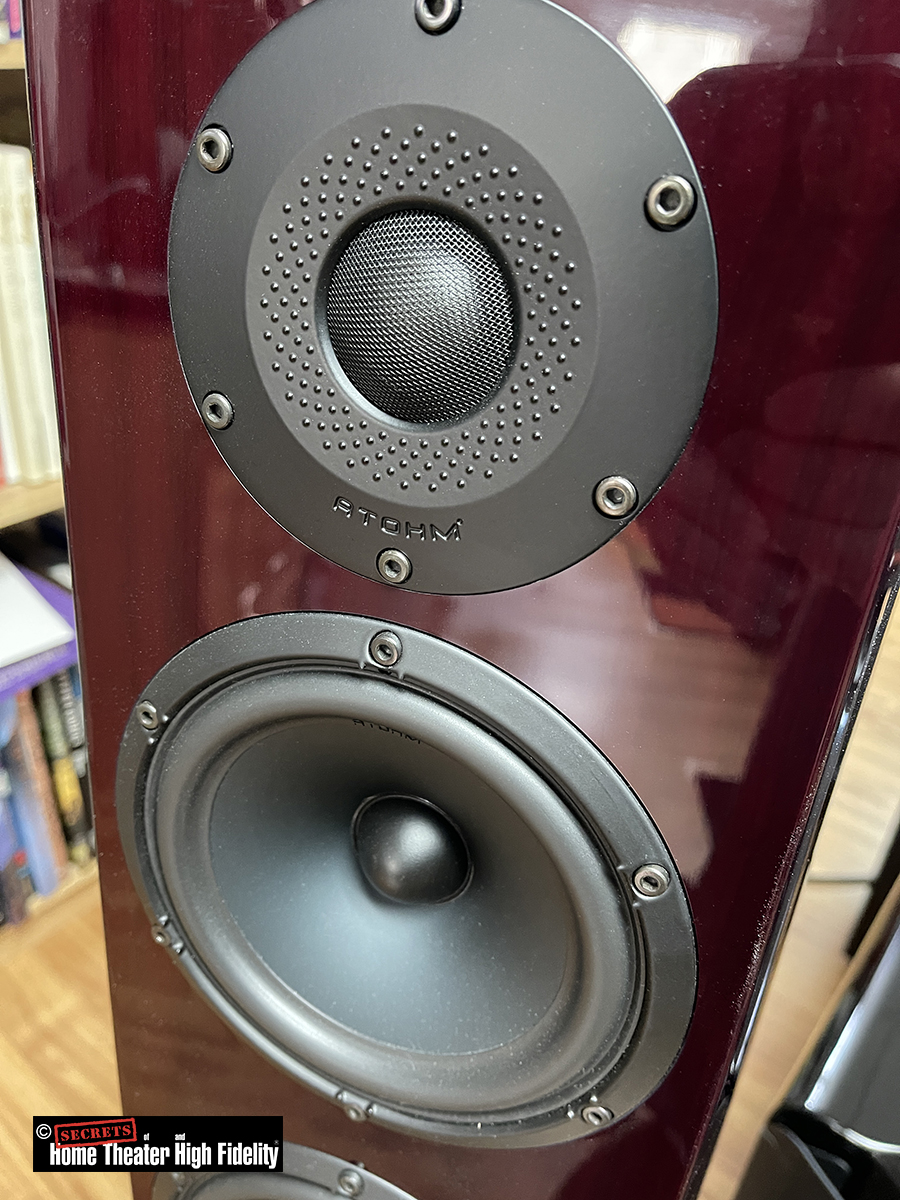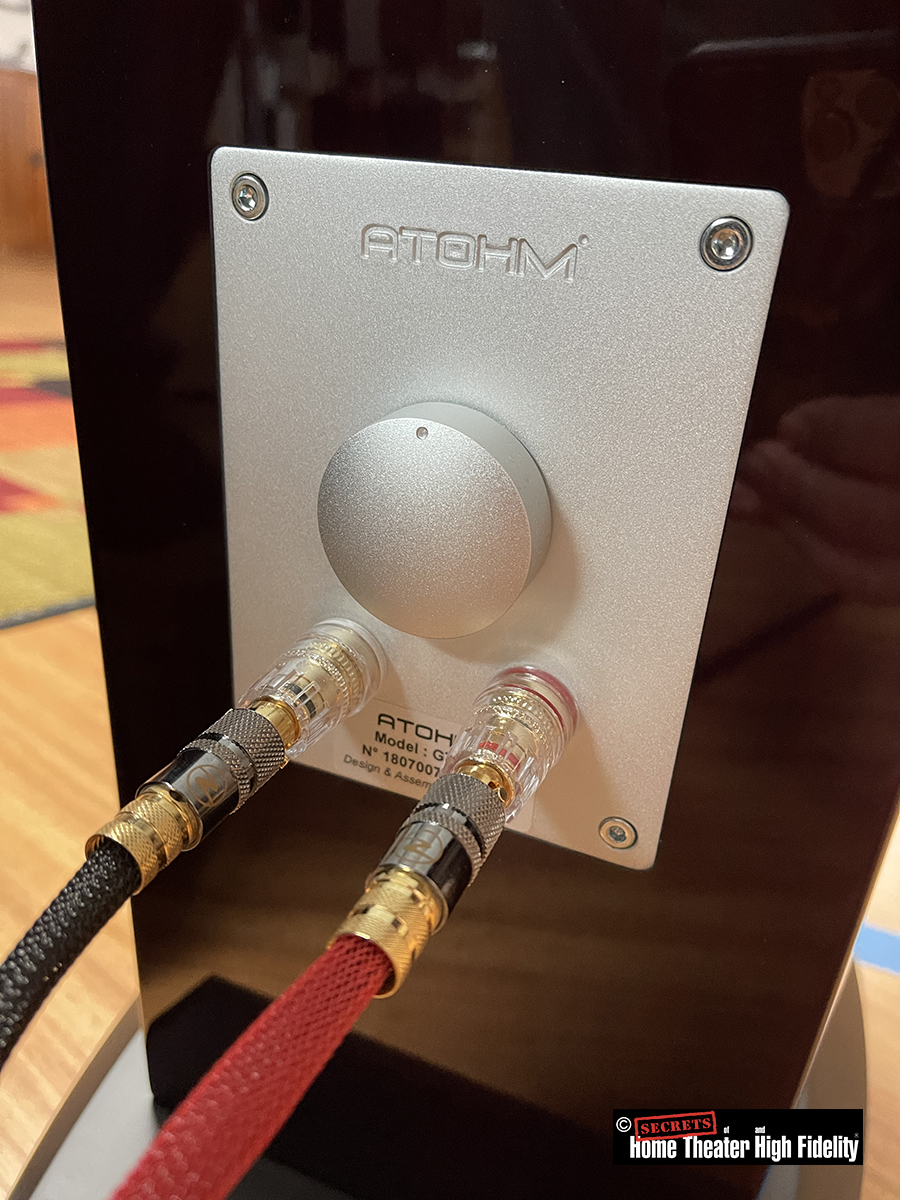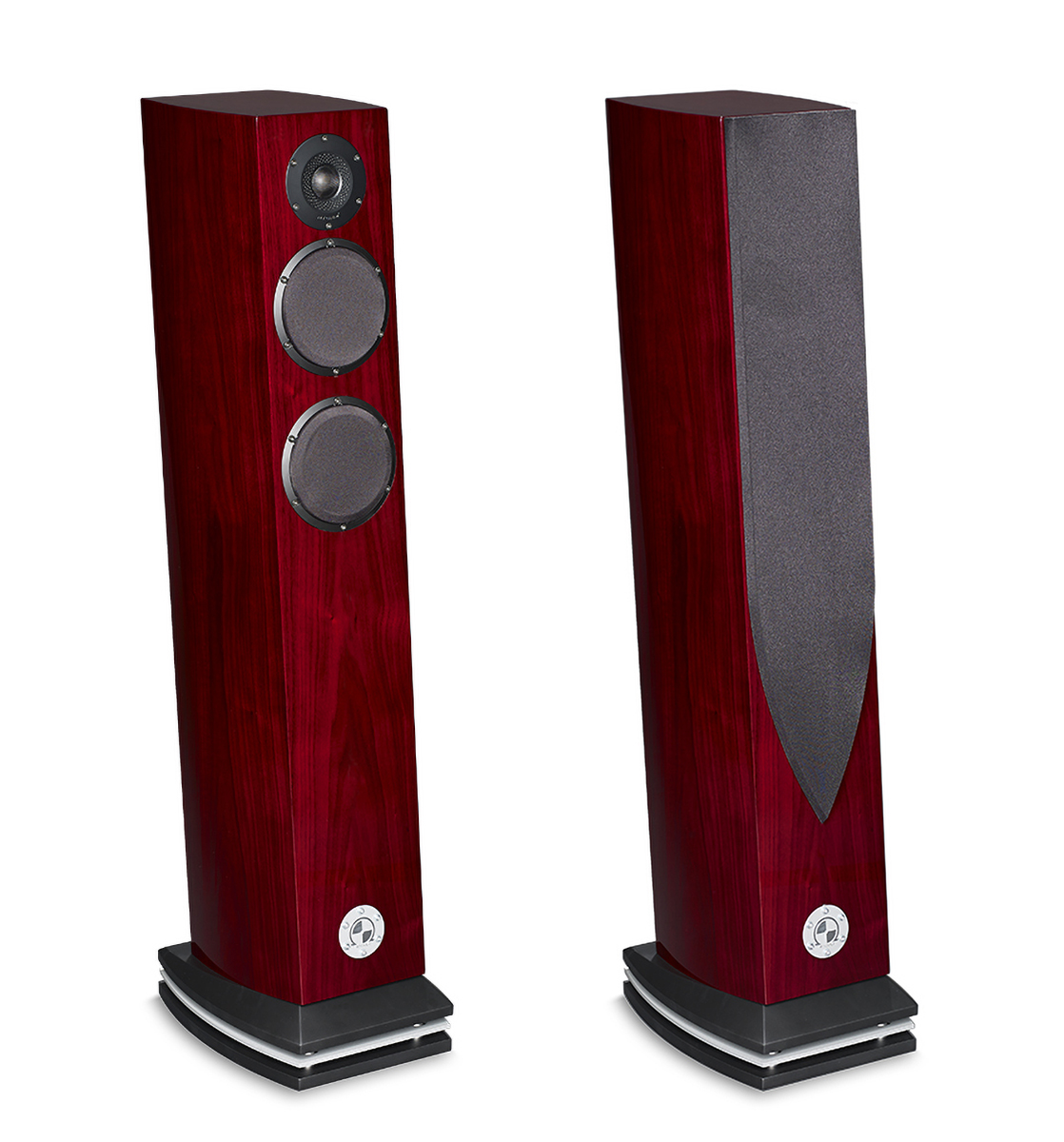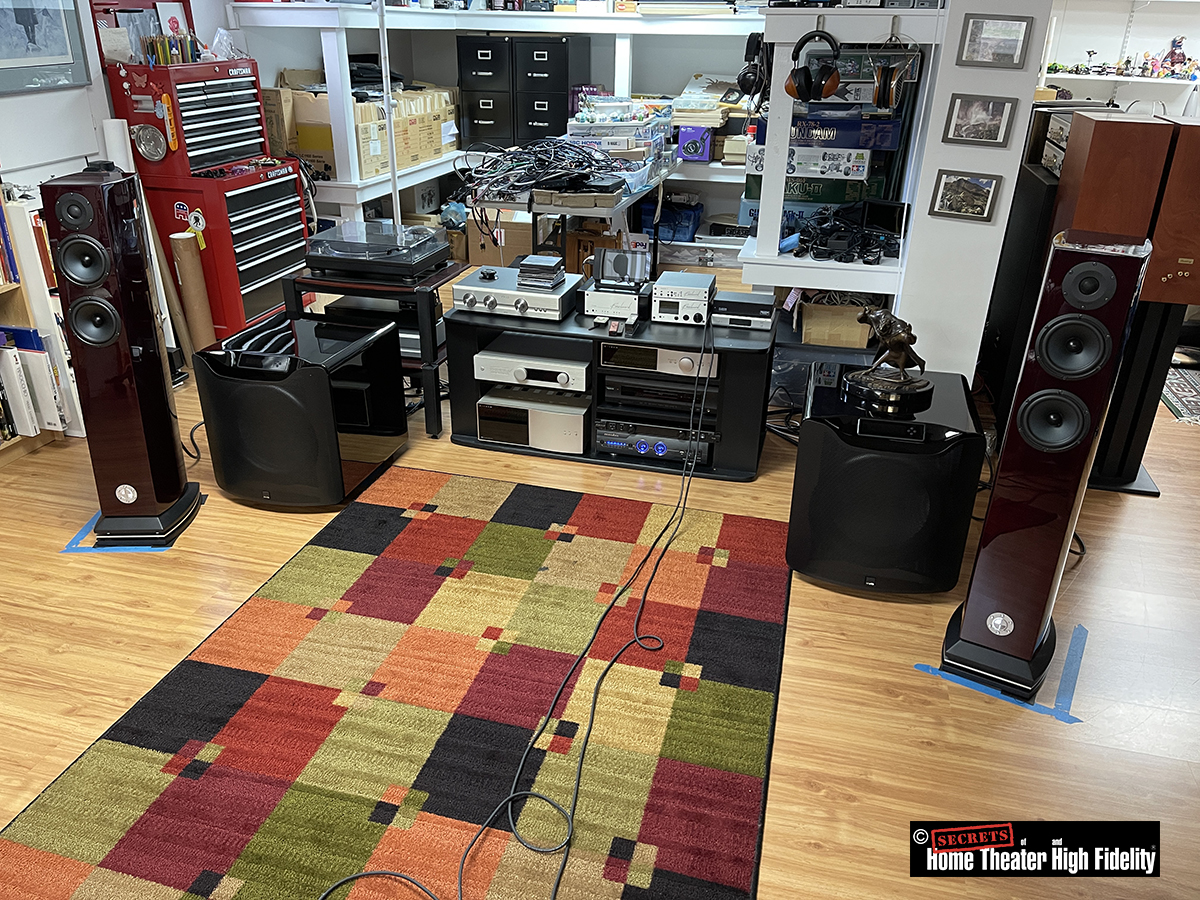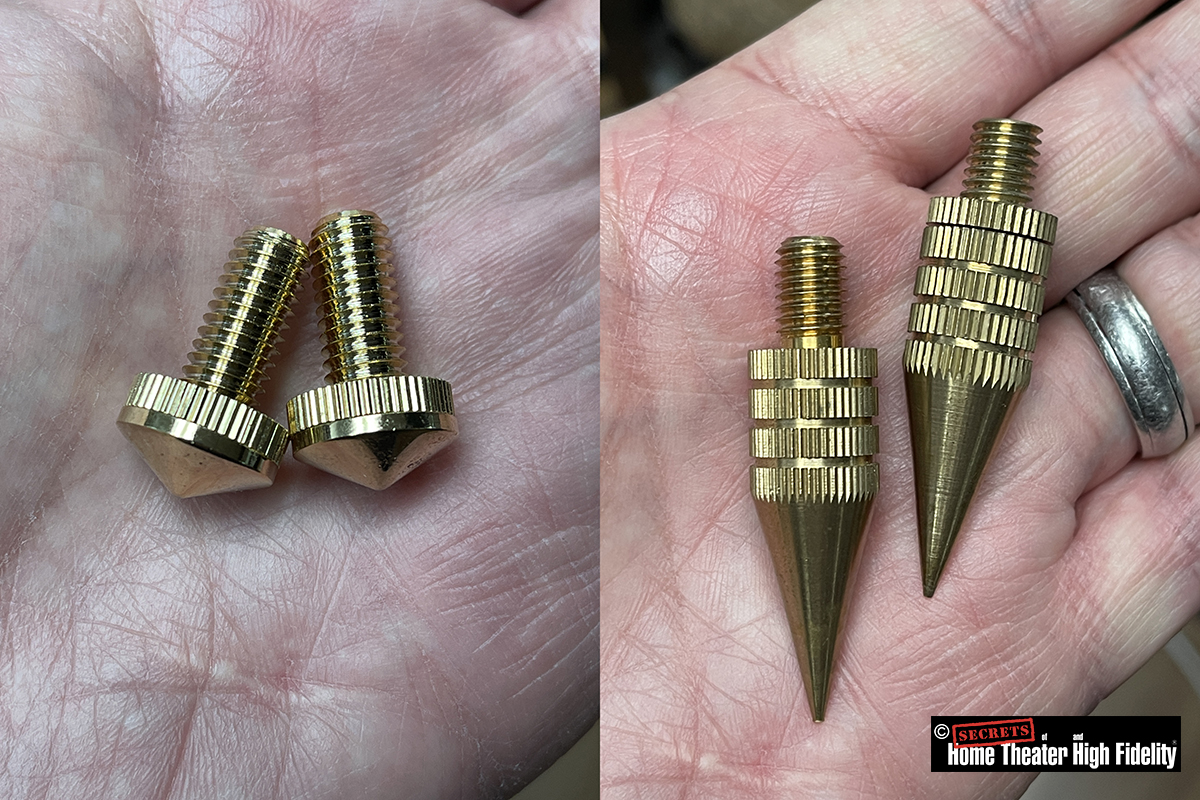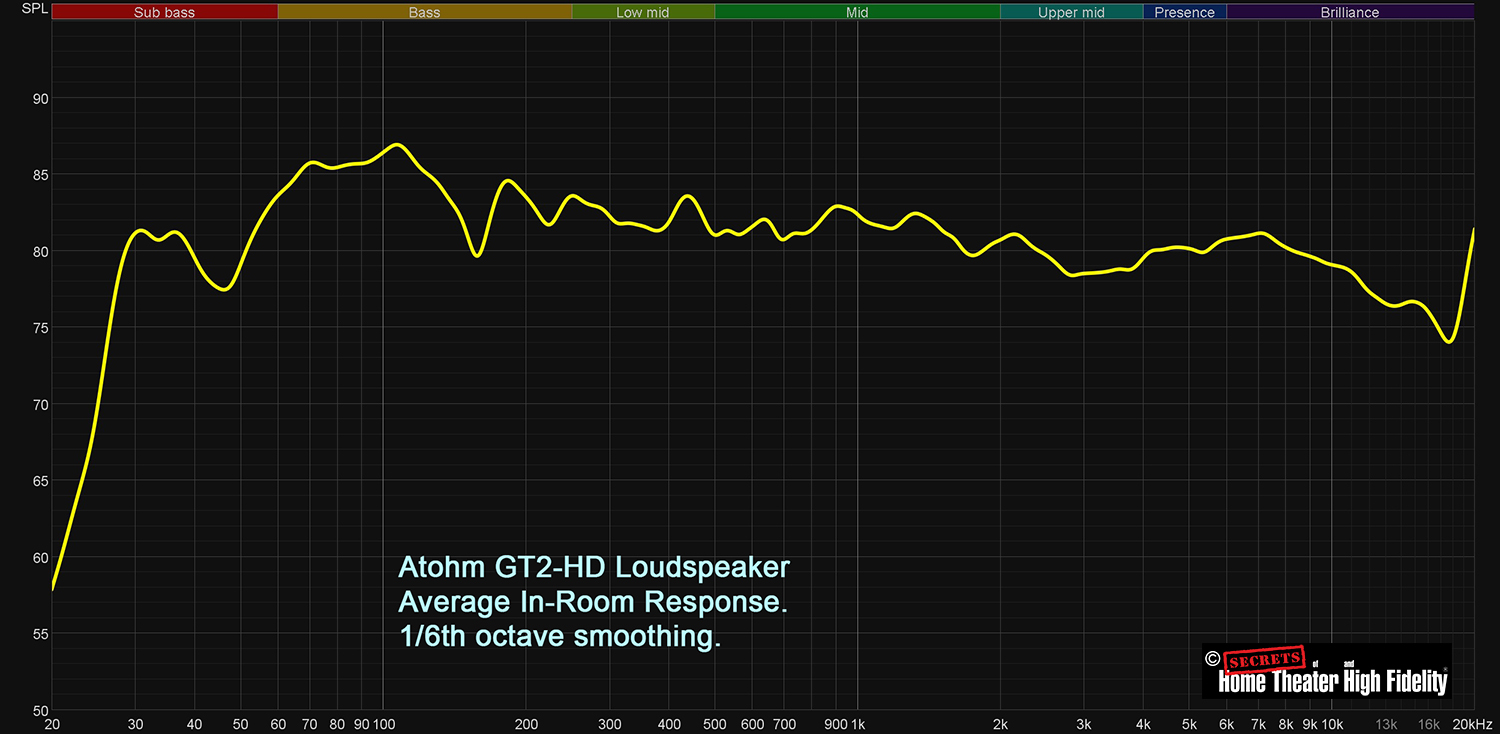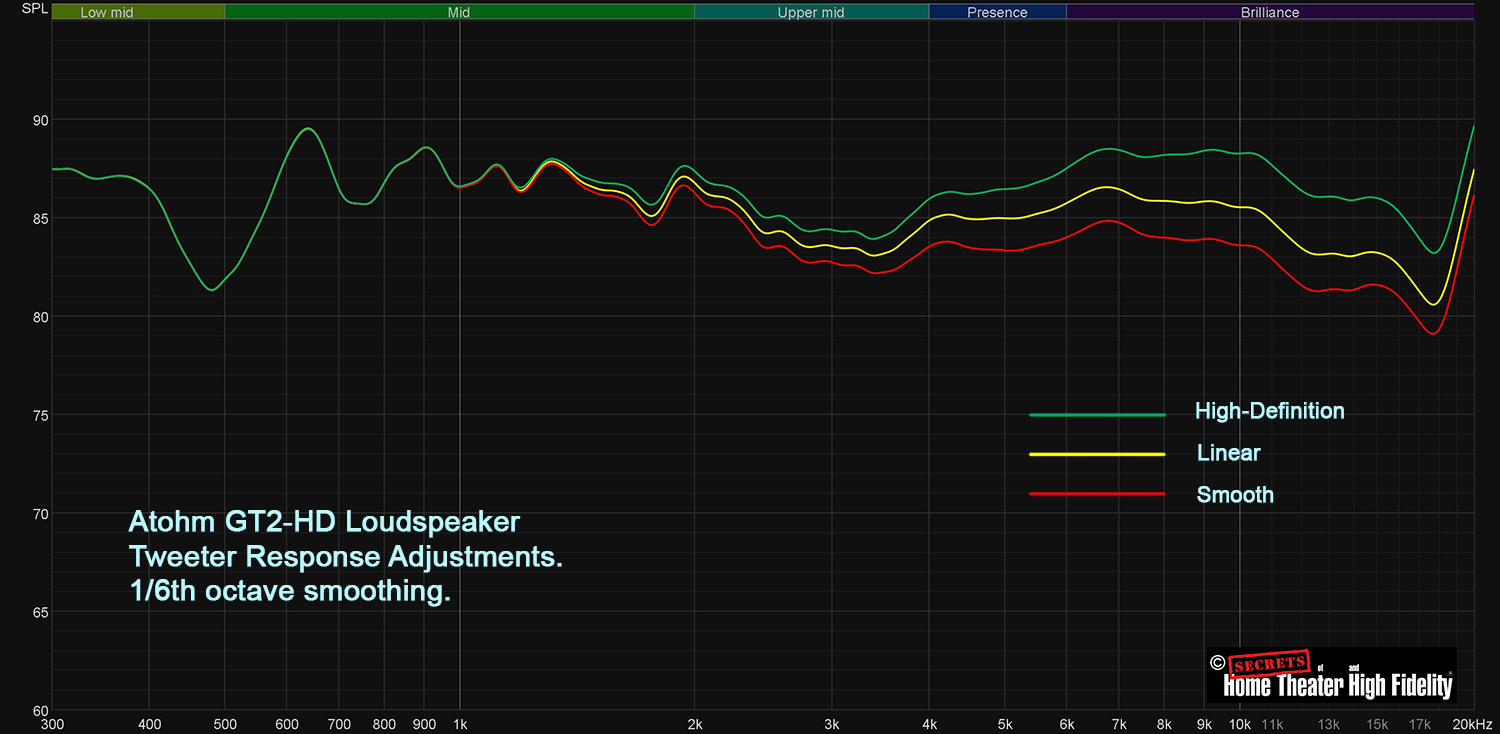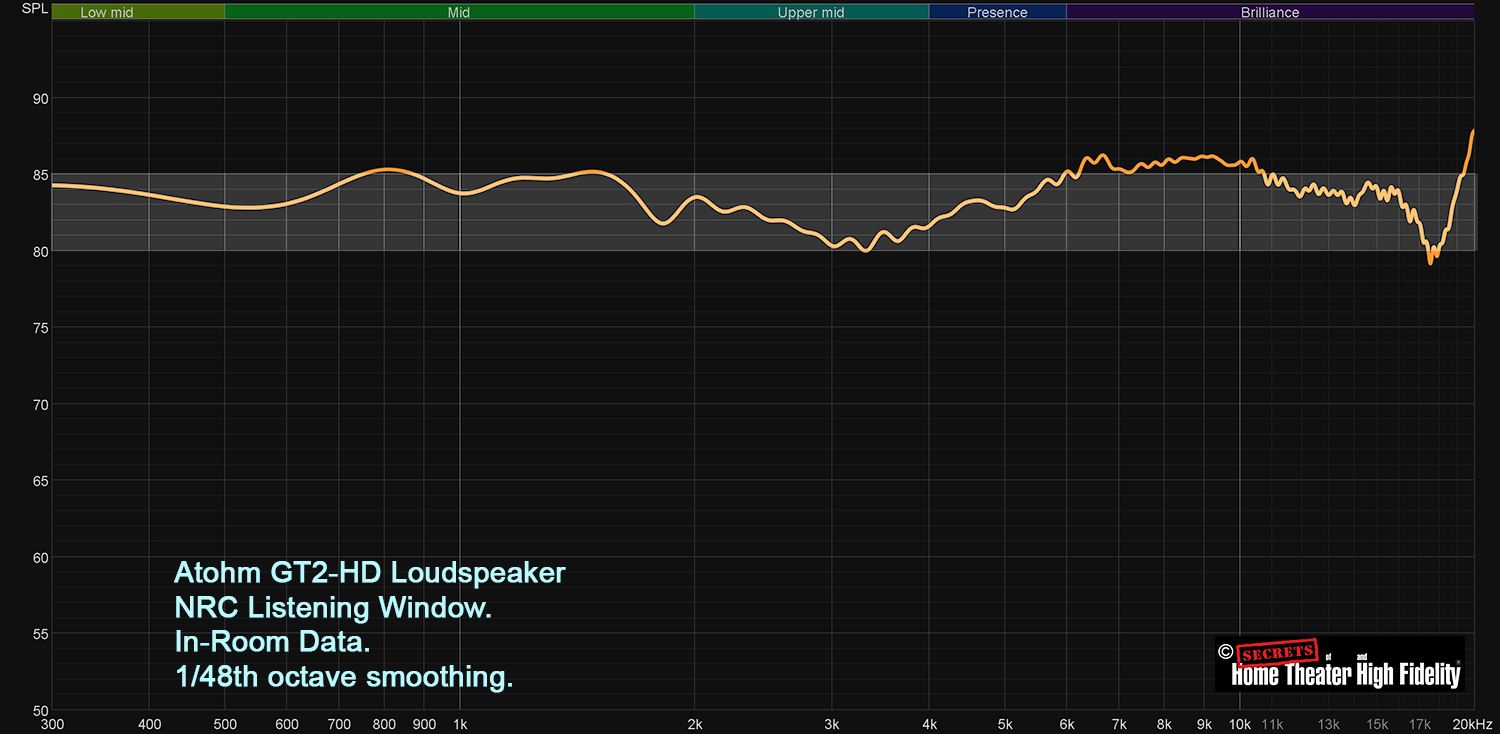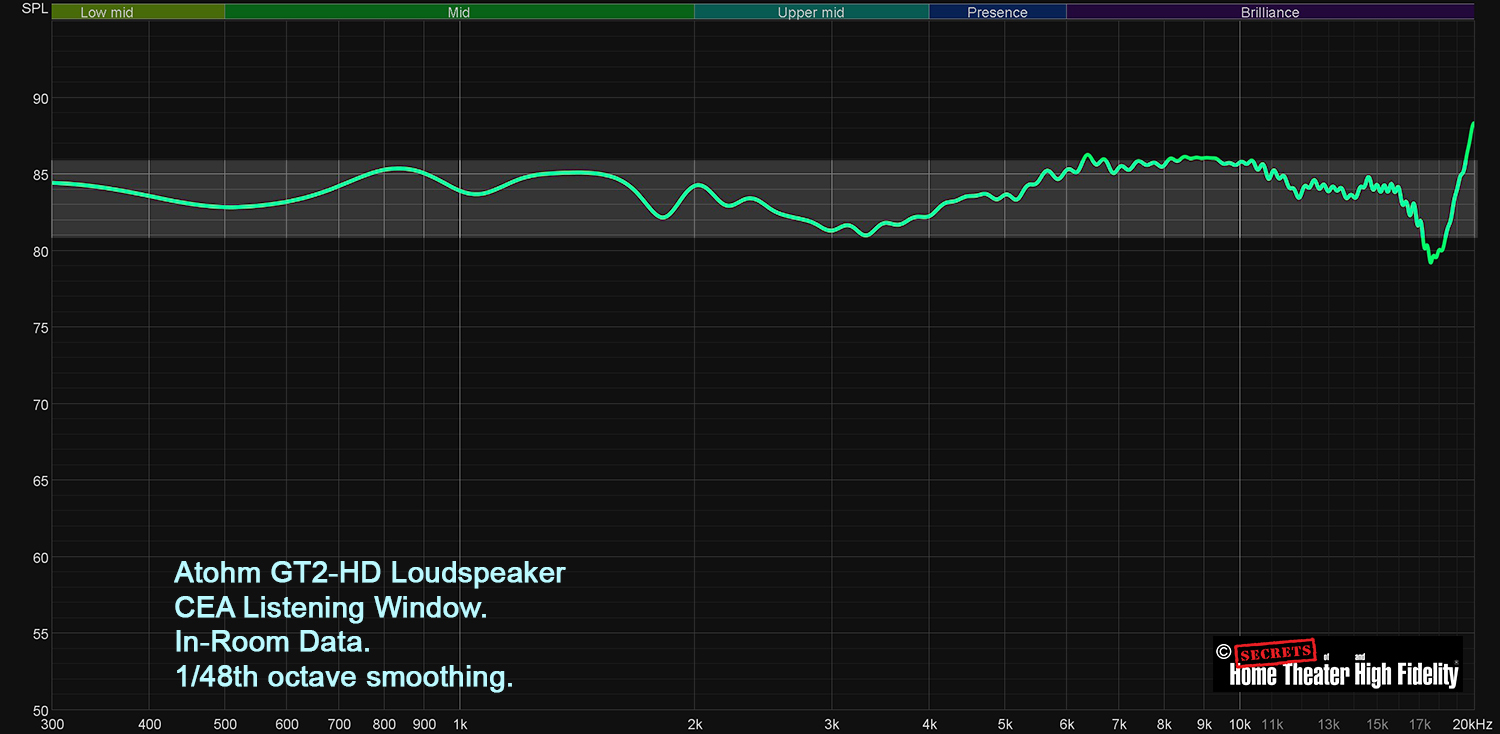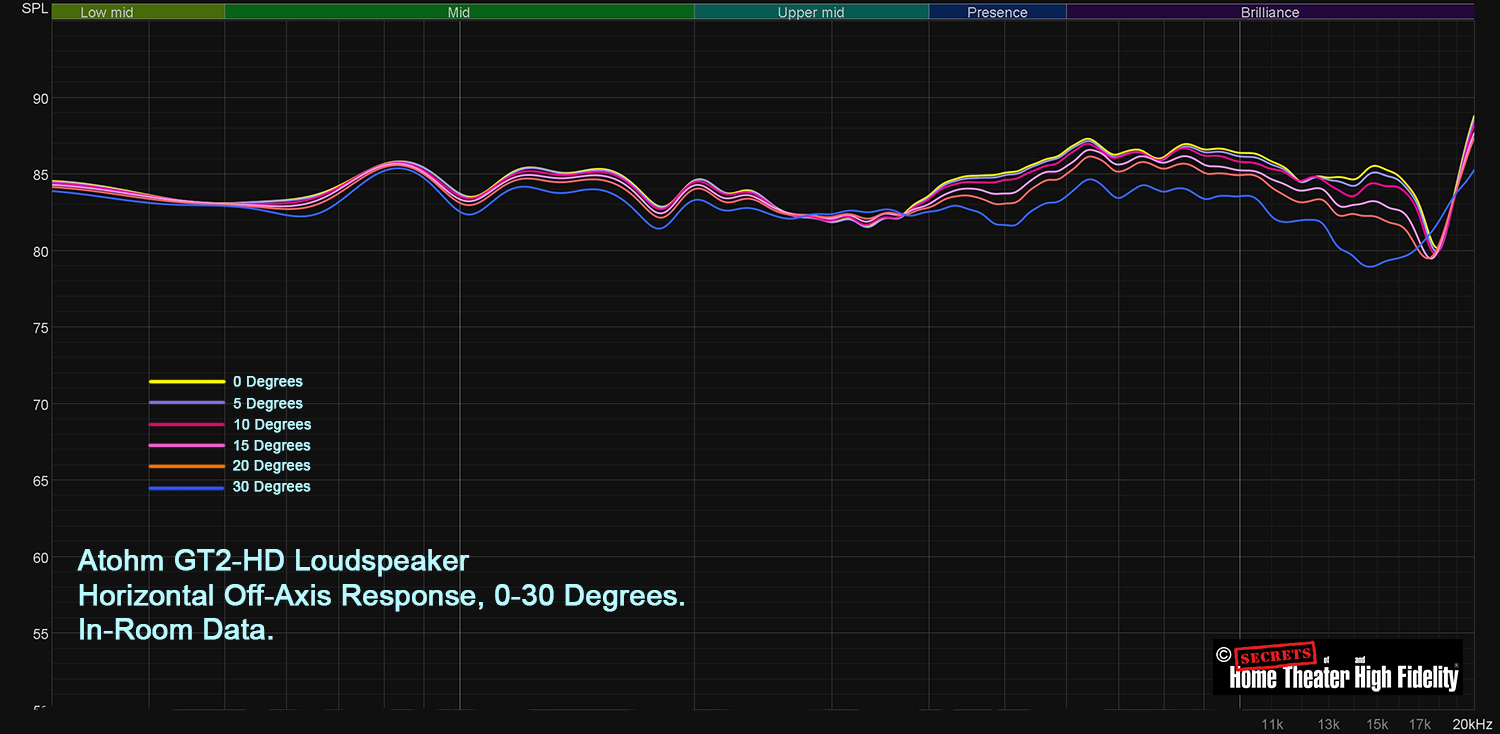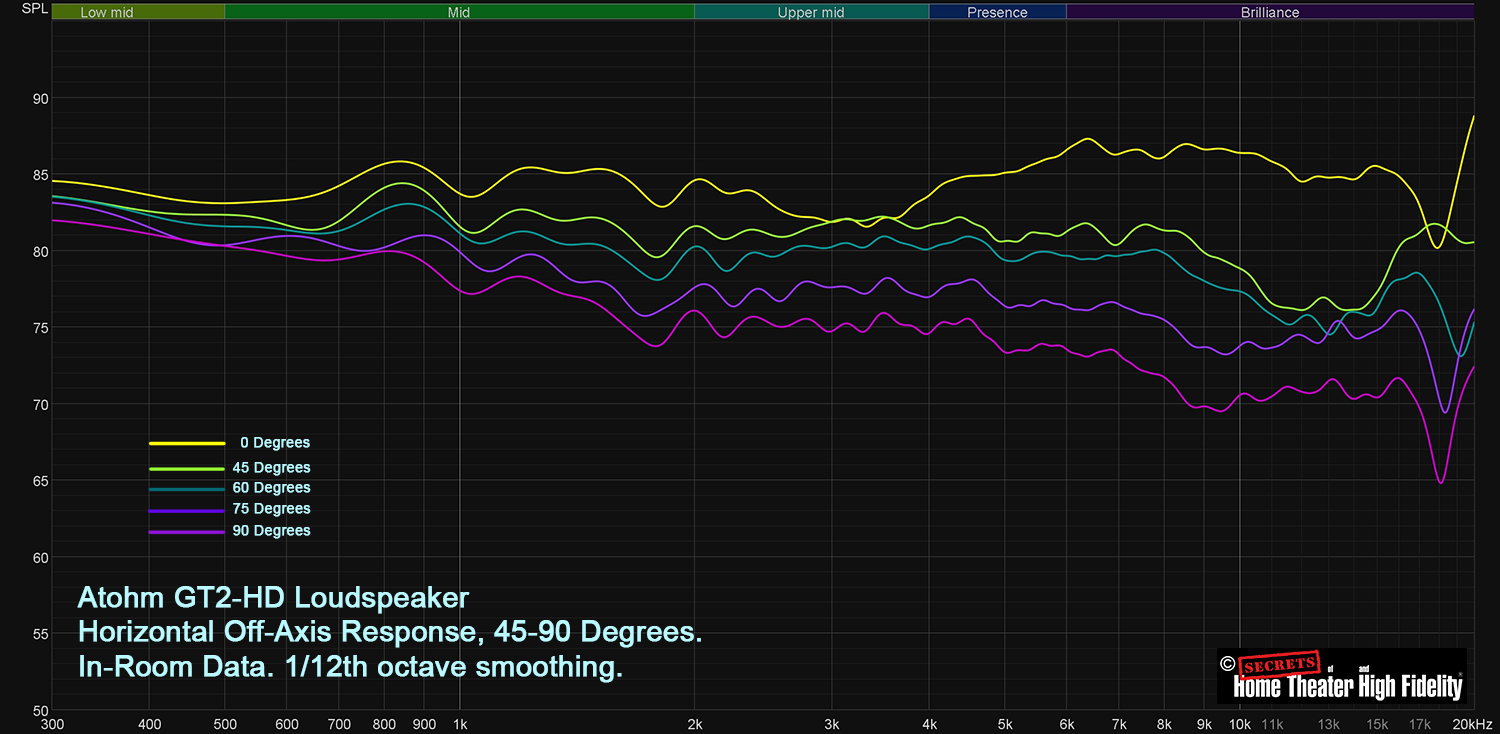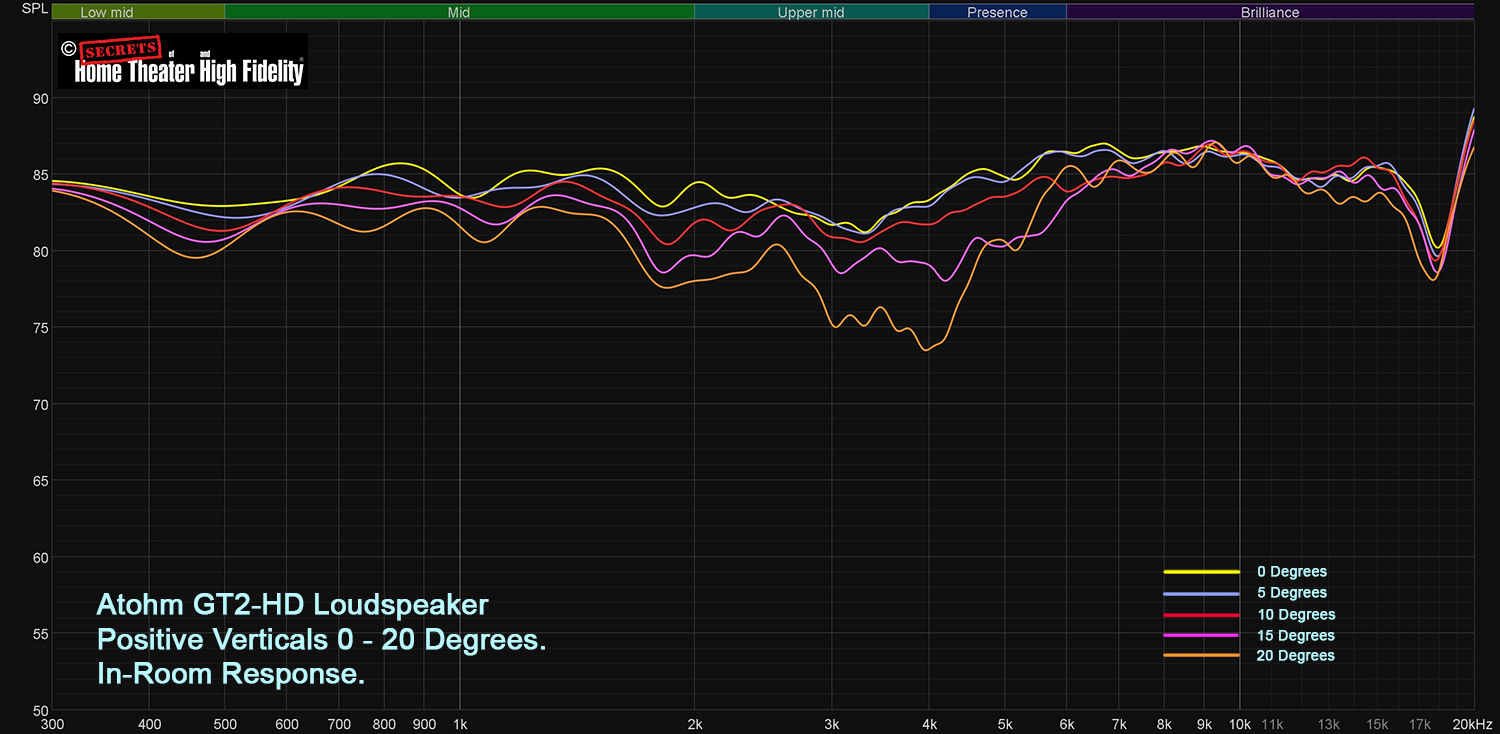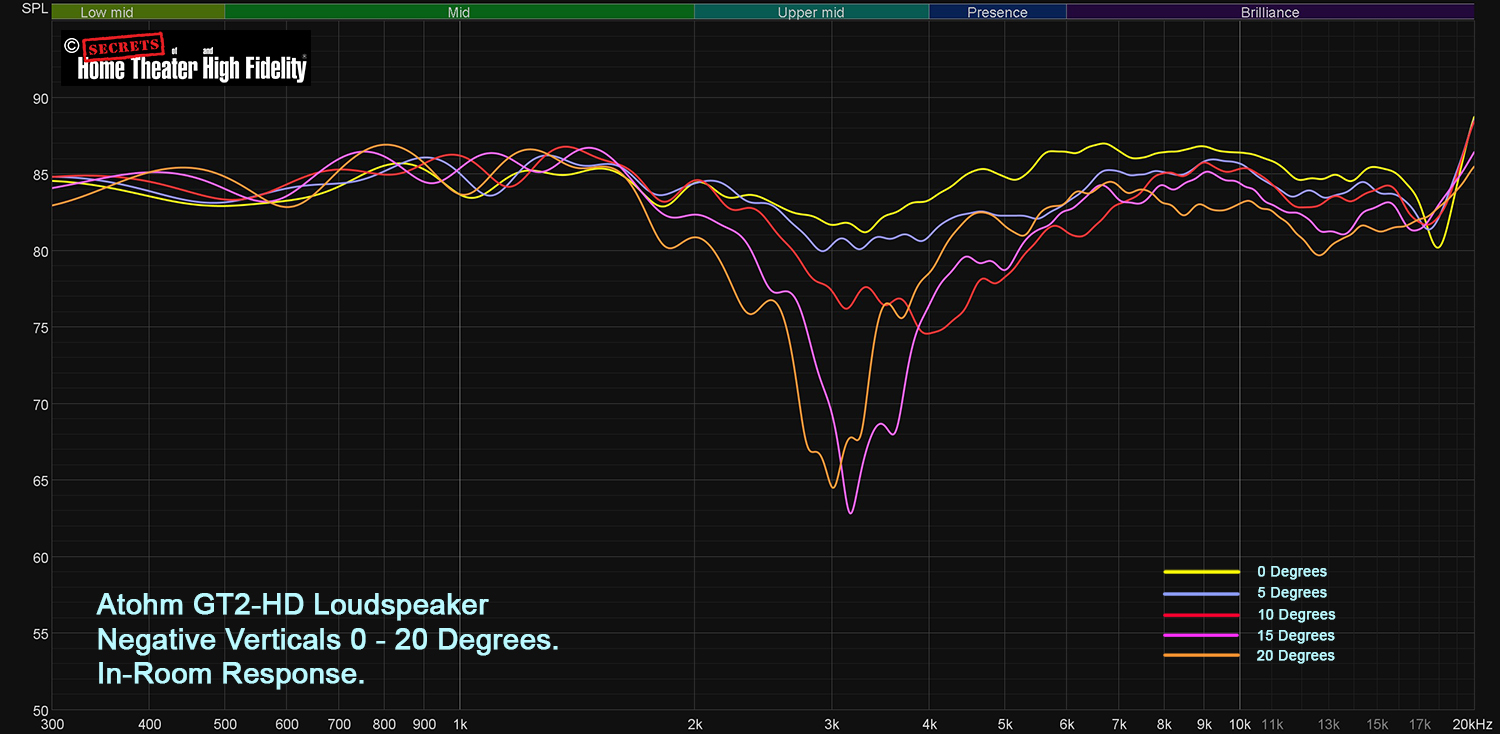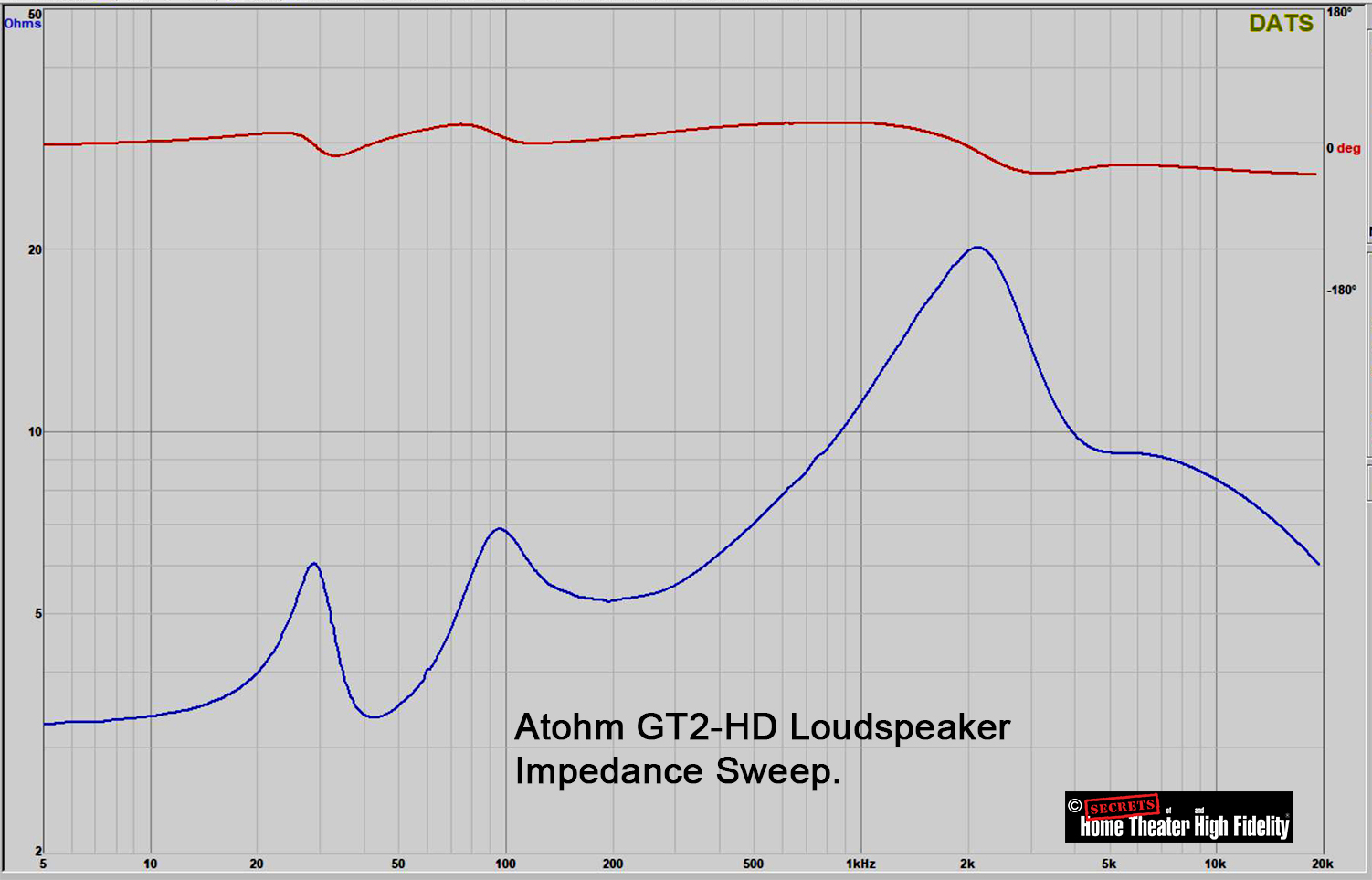When I think of France, images of croissants, Champagne, and the Louvre come to mind. And yet the French are also known to make many a fine and interesting audio product as well. The Atohm GT2-HD loudspeakers are a perfect example of just such a thing.
Slim, elegant, and scrupulously finished, the Atohm GT2-HD floor-standing loudspeakers will cut a very stylish figure in any room. The good looks are also backed up with very appealing sound quality and a surprising bass response from such comparatively slim cabinets. Atohm has built a reputation for high-quality, well-designed speaker drivers, and the results speak for themselves here in the GT2-HD.
Atohm GT2-HD loudspeakers
- Stylish angled cabinets to time-align drivers.
- Very appealing sound signature. Enjoyable to listen to with most kinds of music.
- Deeper bass than you’d expect from speakers of similar size.
- Dial on the back of each speaker allows convenient adjusting of treble response.
- Needs better carpet spikes.
Atohm is a French audio manufacturer that I have been peripherally aware of over the past few years. I knew them to have a reputation for making very high-quality loudspeaker drivers that other companies sourced for their products. But I never knew them to make their own branded loudspeakers until I was approached by Emilios Mandalios of Audio Excellent L.L.C., Atohm’s US distributor. Emilios sent me some information regarding Atohm’s GT line of loudspeakers and, after some discussion, we agreed that the middle-child GT2-HD would be a good fit for my listening space. I was intrigued both by the design of the GT2-HD, in all its svelte rakish glory, and the fact that it was a product that was slightly off the beaten path and might not be familiar to many.
Soon after, a pair of boxes arrived at my doorstep, and I gingerly began the process of unpacking and acclimating to these stylish French twins. “Ooh-la-la” indeed!
Description:
2.5-way, bass reflex floor-standing loudspeaker with down-firing port.
High-Frequency Driver:
Single 28mm silk dome tweeter with integrated waveguide. Atohm SD28 ND04 RD Absolute Series tweeter.
Mid-Low Frequency Driver:
Dual 124mm drivers with special alloy diaphragms. Atohm LD150 Absolute Series Mid-Woofer.
Frequency Response:
40 Hz – 30 kHz (Manufacturer)
Crossover Frequencies:
2.5 kHz (1st Order)
Nominal Impedance:
6 Ohms
Sensitivity (Manufacturer):
90 dB (2.83 Volts @ 1 Meter)
Power Handling:
200 WRMS
Available Finishes:
Piano Black, Piano White, Piano Wengnut, Piano Rosewood (soon to be discontinued)
Dimensions (H x W x D):
42.7” x 8” x 10.5” (inches)
Net weight:
26 kg / 58 lbs. (each)
MSRP:
$7,499.00 (pair)
Website:
SECRETS Tags:
atohm, gt2hd, floor-standing, loudspeakers, hifi
The first thing you’ll notice about the Atohm GT2-HD is its slim angled stature. It makes for an especially handsome-looking speaker, particularly in the burgundy-colored piano Rosewood finish that was sent for review. The rake of the GT2-HD isn’t just for show either. Integral to the design, the angle of the speaker is used to physically time-align the drivers so that the individual direct outputs reach the listener at the same time.
The speaker cabinet sits on a triple-tiered plinth with an opening in the base for the down-firing port. The cabinet construction is 3/4-inch MDF with multi-layer construction to help get the nicely curved sides. At the bottom portion of the cabinet, there is a sealed internal chamber (built around the tuned port) that allows for the filling of sand to additionally weigh down and dampen the speakers.
The fill port can be accessed behind the Atohm logo badge. The plinth is interesting in that it is designed to work as a decoupling system. Upward facing (master) spikes that come in contact with the upper tier of the plinth dissipate energy that is naturally directed to the lowest tier of the plinth, where they stem from. Four additional (secondary) spikes screw into the base and distribute any residual energy to the listening room floor.
Secrets Sponsor
The driver complement is from Atohm’s “Absolute series” of drivers that are completely designed and made in-house. It starts with a single, 28mm (1-inch) treated silk dome tweeter handling the high frequencies. The tweeter dome is ferrofluid cooled and is protected behind a wire mesh. The tweeter is set within a modest aluminum waveguide to help control its dispersion and is powered by a large (56mm) Neodymium magnet motor structure. The powerful magnet combined with the light silk diaphragm allows the tweeter to reach a very high level of efficiency (97 dB) before even being mated to the waveguide. The tweeters in a pair of GT2-HD are also level-matched to within 0.5 dB of each other.
The twin 6-inch mid/bass drivers each have special alloy cones that help push the driver’s breakup frequency well out of band. The cones are mated to a special surround that Atohm terms LDS (Low Diffraction Surrounding) technology and a robust magnet and motor structure. This is said to allow for a higher excursion while keeping distortion very low. The drivers also feature cast aluminum frames.
The crossover design is described as a first-order slope that crosses over to the tweeter at 2.5 kHz. On the back of each speaker, just above the pair of binding posts, is a three-position dial that adjusts the output of the tweeter to account for different listening environments. From left to right the dial positions are labeled “Smooth”, “Linear,” and “High-Definition.” The middle “Linear” position is the default allowing for no change in the tweeter response. The “Smooth” setting correlates to a -2dB output level while “High-Definition” accounts for a +3dB increase in tweeter output level. Due to the tweeter’s especially high efficiency, a 6dB level of attenuation is built into the crossover (in Linear mode) to help mate the tweeter level to the mid/bass drivers.
The Atohm GT2-HD comes with two types of grilles. One is more of a classic, full-length fabric grille that attaches with embedded magnets. The second type is two pairs of metal and fabric rounds that magnetically attach to the mid-woofer driver frames.
Secrets Sponsor
The build quality of the Atohm GT2-HD is of a very high standard.
The Atom GT2-HD loudspeakers were mainly set up in my large studio room, although I did spend some time with them in our home theater room and our upstairs living room to get a better sense of their performance in different environments. The speakers were positioned 8 feet apart with a slight amount of toe-in (roughly 5 degrees). The listening position was 10 feet away from the center point between the speakers.
Attached equipment included:
Preamps: Benchmark Media Systems HPA4, Anthem STR Preamp, Trinnov Amethyst.
Amplifiers: Benchmark Media Systems AHB2, Anthem STR Power Amp, Vera Audio P400/1000.
AVRs and integrated amps: Anthem MRX 1120, Technics SU-R1000, Atoll IN300.
Analog Sources: KAB/Technics SL1200 Mk6 turntable with AT OC9ML/II moving coil cartridge, Pass Labs XP25 Phono preamp, Rotel RQ 970BX Phono preamp.
Digital Sources: OPPO BDP-105D Universal player, GeerFab Audio DBOB, Raspberry Pi-based streaming endpoint, Benchmark Media System DAC3 B.
Interconnect and Speaker Cables: Clarus Cable Aqua, Bluejeans Cables.
As elegant and refined as the Atohm GT2-HD appeared physically, they certainly weren’t the shy and demure type from a sonic perspective. When I had them set up in my large studio space, they sure as heck swung for the fences and belted out a large and engaging audio image. I was actually taken a little aback at the sense of image depth and width that I was getting from these modesty-sized towers. They also don’t mind a liberal hand with the volume control either. Where I may have had preconceived notions of the Atohms not liking much musical variety beyond smooth jazz and chamber orchestra, I quickly had to recalibrate my thinking. Emilios (from Audio Excellent) did insist I “crank them up” after I’d gotten comfortable with them, so the least I could do was oblige his request. The GT2-HD enjoyed several musical diversions of the Van Halen, AC/DC, and Tool variety played at a “more-than-adequate” volume level. All the while the Atohm speakers remained composed and displayed no hint of audible distress at these musical shenanigans. I was listening for any hint of harshness or unpleasant results and got not a whiff of it.
The bass output of the GT2-HD was also a bit of a surprise. I was expecting tight yet polite levels of bass from this lithe French duo. What I got in my big room, while not subterranean, was solid, punchy, and thoroughly enjoyable for most of the music I listen to. While not in the same bass league as the Paradigm Founder 120H, I was not feeling like I needed to hook a subwoofer (or two) up to the Athoms either. In both my home theater and upstairs living room, the bass response felt even more authoritative as the Atohms were placed closer to walls for additional reinforcement.

Brian Bromberg “Hands”
As such, listening to the recent 24/96 re-release of Brian Bromberg’s “Hands” album was particularly satisfying. Hearing all the weight and details of his aggressive plucking and slapping of the acoustic bass coming through the GT2-HD was an unexpected treat. The only real annoyance that I had with these speakers came to light in the rooms that had carpeting. The actual carpet spikes that are included with the Atohms were so dull that they couldn’t properly penetrate a Berber carpet and contact the floor.
Luckily, I had a few sets of more aggressive spikes that were of the same thread size, so I used them for when the GT2-HD were to be on carpets.
The GT2-HD’s tonal balance is very appealing with a great rendering of both male and female vocals that weren’t too forward along with clean, unfatiguing highs. The blend between the silk tweeter and two mid-woofers seemed to be pretty seamless with all the music I listened to. That treated silk tweeter was behaving very nicely, keeping cymbals and brass sounding very detailed without getting irritating. The twin mid-woofers were certainly being kept busy reproducing the bulk of everything else. But those drivers kept everything remarkably tight sounding. Layers of instruments didn’t seem to overwhelm one another. I could easily make out every instrument and vocal detail in a given song, with no real hints of compression even at louder volumes with those drivers.

Jean-Pierre Rampal and Claude Bolling “Suite for Flute and Jazz Piano”
And yes, when I did play some jazz like “Suite for Flute and Jazz Piano” by Jean-Pierre Rampal and Claude Bolling, the Atohms gave Rampal’s flute the sweetest sounding tone, smooth and clear without any edginess. Bolling’s piano work was big and room-filling with a nice ring to the sound of the middle and upper keys but with solid weight given to the lower registers too.
I actually felt that there was a fair similarity between the sound of Atohm GT2-HD and the Revel F228Be speakers that I usually have running here in the studio. With that in mind, I did a quick back-to-back comparison between the Revels and the Atohms with some mono music tracks that allowed me to instantly switch between the two speakers while listening. While I don’t pretend to be the most “trained” of listeners, I couldn’t make out any gaps in the tonal performance of the Atohm speakers as I switched back and forth between them and the Revels. The F228Be definitely had the edge with the relaying of the finest details through the bass and midrange regions, which was to be expected, but the GT2-HD were giving the Revels a good run for their money. The highs on both speakers sounded equally sweet on my classical test tracks. If anything, the Atohms had a slight advantage over the Revels on image depth versus width. Overall, this was an enjoyable and surprising performance from a pair of slimmer towers placed in the middle of a large room. Give them a solid 100 to 150 watts of power and they will really start singing. While they sounded great with all the equipment I had on hand, the Atohms particularly seemed to like being hooked up to the big Vera Audio and Anthem STR amps.
Measurements by Carlo Lo Raso, analysis by Carlo Lo Raso and David A. Rich.
Bench tests were performed with a Cross Spectrum Labs calibrated Earthworks M30 microphone connected to my computer workstation using Room EQ Wizard acoustic measurement software, a Lynx 2B professional sound card, and an M-Audio microphone preamp. On and off-axis measurements were taken with the mic at 1-meter from the center point between the tweeter and the upper mid-bass driver as the 0-degree reference point. Unlike measurements taken outdoors or in an anechoic chamber that measure a speaker in isolation (and assess straight-line engineering), in-room measurements give a sense of how a speaker behaves in the actual environment that it’s used. Both types of measurements are valuable (a properly designed speaker in an anechoic environment tends to hold up well in an average listening space), I just find in-room measurements interesting as they help shed light on what I am hearing and why. That and I don’t own an anechoic chamber!
Impedance measurements were taken using the Dayton Audio DATS v3 loudspeaker tester and software.
All measurements, unless otherwise noted, were taken in my large basement studio space.
The in-room measurement is an 18-point spatial average. A 9-point measurement was made for the right speaker and then repeated for the left speaker. Averaging both speakers is an approach others have been using and publishing. Using data from both speakers reduces the modal response of the room by averaging the differences in the response of the two speakers from room asymmetries. The technique cannot eliminate them and the response below 300Hz remains room dominated. The results show the Atohm GT2-HD has a controlled response from 200 Hz to about 10 kHz where the tweeter begins to roll off in-room. The tweeter response drops by 5dB at 17 kHz after which it jumps by 7dB at 20 kHz. There is also a shallow dip in the response from 2.5 kHz to 4kHz, starting at where the tweeter comes into play. Below 250 Hz, the response increasingly becomes more room dominated. There is a modest room-gain-hump from 55 Hz to 130 Hz adding a nice sense of punch to the bass. We then see a null in the response at 45 Hz which is a characteristic of the room. We get a modest return in response between 29Hz and 40 Hz before the bass steeply rolls off below 28 Hz. The response dips at 160 Hz and 220 Hz are room artifacts that show up in pretty much all my measurements in this room. Room correction such as DIRAC or Anthem ARC, applied from 200 Hz on down, would have an easy time sorting out any bass deficiencies brought on by the room here. As it stands though, a solid bass response to just under 30 Hz in this rather bass-unfriendly room is pretty remarkable for speakers of this size and type. There are a few ways that this can be achieved, but since I observed how much the GT2-HD liked being hooked up to the bigger amps, we surmise that the efficiency of these speakers is more like 87 dB or lower in the real world.
This is a plot that illustrates the different effects of the three settings of the tweeter adjustment dial. These measurements were taken at a distance of 1 meter from the acoustic center. The yellow plot is the default “Linear” setting, the green plot is at the “High-Definition” setting showing an increase of up to +3dB. The red plot is at the “Smooth” setting showing a drop of up to -2dB below the default setting.
David Rich notes: The measurements that follow are with the linear setting on the tweeter adjustment dial. As we will see the measurements look much better if you imagine the tweeter down 2 dB.
This is a plot of the NRC listening window for the Atohm GT2-HD scaled from 300 Hz on up which is averaged from the following measurements: 0-degree on-axis, +-15-degrees vertical and +-15-degrees horizontal. This is the portion of the frequency range that is dominated by the speaker (response below 300 Hz tends to be dominated by the room and can vary greatly).
David Rich notes: The speaker’s vertical response is not the best, owing to the low order crossover. The NRC window has two vertical measurements at 15 degrees off-axis and only two horizontal measurements at 15 degrees off-axis. As we will see, things improve in the CEA-2034A listening window.
This is a plot of the CEA-2034A listening window for the Atohm GT2-HD scaled from 300 Hz on up which is averaged from the following measurements: 0-degree on-axis, +-10-degrees vertical, +-10-degrees, and +- 20-degrees horizontal. This is the portion of the frequency range that is dominated by the speaker (response below 300 Hz tends to be dominated by the room and can vary greatly).
David Rich notes: Note how much better this is. The depression at the crossover is reduced and the tweeter response has smoothed out. Not only are the vertical angles reduced to +/- 10 degrees which is why the depression has reduced, but this listening window is comprised of 6 horizontal measurements with the added 30 degrees smoothing the tweeter response. Now imagine the –2dB tweeter pad was selected and the tweeter response moves close to the midrange level. The dip in the crossover is translated to Carlo’s subjective impression that “the Atohms had a slight advantage over the Revels on image depth versus width”.
This dip between roughly 1.5 kHz and 4 kHz has to do with the narrow width of the front baffle. It helps in keeping horizontal off-axis response more consistent.
Above are the horizontal radiation curves of the Atohm GT2-HD from 0 to 30 degrees, scaled from 300 Hz on up, measured in-room.
David Rich notes: Again, think if the tweeter was down 2dB. The crossover dip is here but the tweeter is performing well.
Above are the horizontal radiation curves of the Atohm GT2-HD from 45 to 90 degrees, scaled from 300 Hz on up, measured in-room.
David Rich notes: Not sure if the dimples on the tweeter waveguide are designed to do anything but the curves show the waveguide Atohm designed is keeping the tweeter from snapping back after the crossover. Once again, think how much better it would look with the tweeter 2 dB down.
Moving to the vertical radiation pattern for positive angles, we see the plots for 0 to +20 degrees, scaled from 300 Hz on up, measured in-room.
David Rich notes: This is not a speaker to stand up and play “air conductor” to, but the positive vertical response is not looking as bad off-axis as a true first-order crossover would.
Moving to the vertical radiation pattern for negative angles, we see the plots for 0 to -20 degrees, scaled from 300 Hz on up, measured in-room.
David Rich notes: Now we see the big crossover cancelation resulting from the low order crossover.
This is not looking good for any axis below 5 degrees. It is clear the designers were optimizing around an average seated listener’s position but all this response error winds up bouncing on the floor and then to your ears.
Note how things are almost unchanged below 2 kHz. Now go back to the positive angle curve above. It’s moving around significantly. It almost looks like a different speaker. This is due to the 2.5-way design. Going down, the mic is always seeing the woofers. Going up, the mic is pulling away from the woofers and the pair of woofers is very directional (13-inch vertical height). The lower woofer is not being turned off fast enough to reduce the directivity. It’s a problem with all these 2.5-way designs although it’s a little more apparent with this speaker.
Here we have the Impedance sweep for the Atohm GT2-HD. The results show that the speaker remains above 5-Ohms through the entire range above 70 Hz, with a peak as high as 20-Ohms at 2 kHz. Below 70 Hz, the results remain consistently between 3 to 4-Ohms with a 6-Ohm peak at 30 Hz. The nominal 6-Ohm Impedance spec looks to be accurate.
Here we have the Step Response for the Atohm GT2-HD.
David Rich notes: Finally we look at the time domain performance with the speaker’s step response. It is clearly not a 1st order crossover. All drivers are in phase but the tweeter arrives before the woofer. Looking at the woofer the impulse appears extended. The lower woofer is arriving slightly later than the upper woofer.
This delay in the step response does not occur with speakers that have the simplest crossover network with a single reactive element for each driver. Vandersteen is the best known of these that is still in production. Recall the Vandersteen and similar speakers have significant baffle tilts and stepped drivers. An explanation of how a 2.5 way looks in the time domain by John Atkinson is found above figure 8 of the review cited here. Note, I am referencing this speaker’s step response only to show what happens in a 2.5-way design. This speaker does not have the tweeter in-phase with the woofers.
Atohm’s Chief Designer, Thierry Comte, explains how the Vandersteen example is different from his design:
“The front baffle has a very important vertical angle. Thus, in speakers when you place a microphone on the axis of the tweeter or close, the time origin of the midbass and time origin of tweeter are almost equal. (Note the time origin is established by the voice coil position, not really by the driver cone itself—so that’s why the angle is so huge in their design. In our case, we put a much lower baffle angle (3 degrees only) and we add an all-pass crossover on the tweeter channel to improve the time delay”
“However all-pass crossovers are not a pure constant delay. It varies according to frequency, and it cannot bring enough time delay to compensate exactly. So, we have to deal with it and with the exact phase behavior at the frequency point”
The ATOHM GT2-HD are both a beautiful looking and sounding pair of loudspeakers brought to you from our friends in France. Meant for those who are looking for something more than just a fine-sounding commodity item.
- Very appealing sound quality, with great tonal balance.
- High-quality parts, build, and finishing.
- Stylish-looking design.
- Moderate size.
- Replace included carpet spikes with something more useful.
The Atohm GT2-HD loudspeakers were a lovely little surprise for me. Not only did they sound very pleasing and capable with a wide variety of music, but they also look very elegant. Visually, a step above the norm. They would work very well with most kinds of decor and are interesting to look at without posing the danger of dominating a room. As I was wrapping up this review, I was informed that the piano rosewood finish of my review units will be discontinued which is a real shame as I think the finish is properly exquisite. Sonically they compare very well with some more expensive speakers like the Revels, which is good because, at $7,499 per pair, they aren’t exactly a snap-buy or value play either. What they are is very refined, both in sound and in looks. The quality and thought put into the design of the GT2-HD are quite apparent, and they feel suitably special. Too many speakers out there (while they may sound good) have almost a disposable or commodity feel about them. The Atohms have that intangible, almost heirloom quality about them. They are the kind of product you could easily want to hold on to and pass on to your kids. If you are looking for high-quality, great-sounding speakers, in a smaller package, there are several options out there. If you want all that along with a choice that may be a little out of the ordinary, the Atohm GT2-HD are certainly worth your time. You may be as pleasantly surprised as I was!
The author would like to thank David A. Rich for his valuable assistance in this review.


